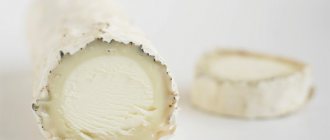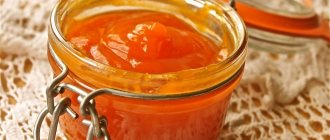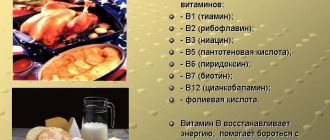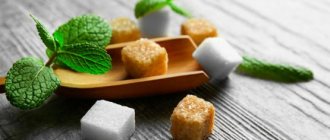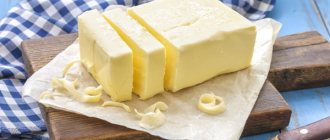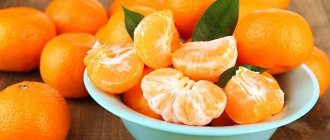The practice of preparing sweet preparations for the winter has come to our region since the times of ancient Rus'. A particularly popular preserve in this category then and now is plum jam. This is explained by the widespread cultivation of such trees, many different varieties and a whole carload of nutrients in the composition.
Today there are many options for preparations based on yellow, white, and royal black plums that deserve attention. But to prepare them correctly and subsequently preserve most of the useful components, you need to learn some tricks.
The benefits and harms of plums for weight loss
The energy value of a plum is 42 kcal per 100, and during a fasting day you can eat up to 1.5 kg of this fruit. But more often in diets it comes in combination with something.
Read: The benefits of dried kiwi
The benefits for weight loss are manifested in delicate laxative and diuretic properties, as a result of which the body gets rid of toxins, salts and excess fluid. And such cleansing, we note, is a prerequisite for many weight loss plans.
Plum, finally, perfectly suppresses the feeling of hunger. Breakfast with her for the whole day provides a surge of physical strength, and also has a positive effect on the psycho-emotional state and protects against stress. And thanks to all this, the risk of breaking the diet is minimized.
Due to the high content of vitamins (A, E and almost the entire group B) and minerals (potassium, zinc, magnesium, beta-carotene, sulfur, nickel, iron), the fruit prevents deterioration in the condition of the skin, hair and nails, which, unfortunately, often accompanies the process of losing weight as a result of the menu being limited in variety and volume.
Moreover, with plums in your diet, when losing weight, your skin will sag less and cellulite will go away faster.
If you have chronic gastrointestinal diseases, in order to avoid their exacerbation, you should consult a specialist about the admissibility of the plum diet.
Video on the topic:
Plum for type 2 diabetes
If you are wondering whether plums are allowed for type 2 diabetes, then, firstly, you have come to the right place, and secondly, you are doing the right thing by asking. Fruits are a risk area for a diabetic, so you should always clarify what is allowed and what is not.
Important! For those who love plums, the good news is that you can eat plums if you have diabetes. Their calorie content is very low - only 46 calories, and the glycemic index is one of the best - 22
The fiber in the fruit allows fructose to be absorbed slowly, while simultaneously saturating the body with calcium, potassium, iodine, carotene and a whole list of vitamins. In general, some advantages.
Perhaps you need to remember the usefulness of fresh fruit and the uselessness of heat-treated fruit. Plum jam is all sugar and a complete lack of vitamins. Prunes - dried plums - are a storehouse of minerals, but they are not recommended for diabetics.
But plum juice or something from this series, the same smoothies based on plums, for example, are undesirable, since they lack fiber and fructose from them enters the body too quickly. Therefore, only fresh and juicy plums remain. And this, you see, is already a lot. You will definitely get benefits from the fruit:
- plum prevents and treats parallel diseases (which already arise against the background of diabetes);
- slows down the aging process;
- relieves acidity in the body, alkalizing it;
- copes with toxins and constipation.
But that's not all. Those suffering from diabetes usually have 3 problems associated with inflammation, kidneys and weakened vision. So, it is the plum that copes with all this.
- Thanks to salicylic acid, the fruit relieves inflammation.
- Plums improve kidney function, loosening the grip of pyelonephritis and cystitis, if you are already familiar with these diseases.
- Fruits have a beneficial effect on the structure of the retina, coping with pathologies.
With such a vast array of superfoods to choose from, how much plum can you eat? For diabetes mellitus, the safe daily intake does not exceed 200 g. This is quite enough to replenish the body with vitamins, but without exposing yourself to unnecessary risk.
We have already partially answered the question of what plums contain, above. It's better to eat them fresh before your main meal. Yes, you can add fruit to low-carb baked goods or even use it as a base for sauce. But why? Most of the properties will be lost, and you won’t even feel the taste. Naturalness is our everything.
To summarize: plums are allowed for type 2 diabetes. Eat for your health, but remember about moderation (up to 200 g) and benefits (eat plums only with fresh and whole fruits). It is under such conditions that you will receive maximum benefits for the body.
Health benefits and harms of plum seeds
Plum pits, or rather the kernels, consist of hard shells, are very tasty and are well known in cooking and folk medicine (tinctures are made from them).
Read: The benefits of dried prunes
But many people have a question: are they really poisonous? Theoretically, in the human stomach, a substance from them called amygdalin is converted into hydrocyanic acid, but in minimal quantities there is no harm from this. Therefore, there is simply no need to eat handfuls of kernels or compotes, jams with plums with pits, which have been stored for more than a year.
On the other, useful side, the seeds of these fruits are unique for:
- prevention of cancer;
- treatment of cough of unknown etiology;
- preventing premature aging of the body;
- treatment of inflammatory diseases of internal organs.
Video on the topic:
Homemade prune wine is a simple recipe. Homemade prune wine recipe
Prunes are dried plums with a unique taste and aroma. It is used to add to various desserts, baked goods and cocktails. Homemade prune wine is one of the most unusual and delicious alcoholic drinks that is easy to prepare at home.
Thanks to natural drying, the fruits of this plum not only have a bright taste, but also contain many useful substances. A natural drink in moderate quantities can serve as an excellent preventive and restorative remedy for the treatment of vitamin deficiency and colds.
A simple recipe for prune wine will appeal to all lovers of natural alcoholic drinks. Making mash does not require the addition of yeast, so the wine is suitable even for those who experience problems with the digestive system.
Before making wine from prunes, you do not need to wash dried fruits, just sort them out and remove severely damaged and spoiled berries. Grind a glass of plums in a blender or meat grinder and transfer to a liter jar. Pour 2-3 tbsp into the prepared puree. spoons of sugar, stir and pour in a glass of warm water.
Place the starter for homemade wine in a warm place for 4 days to ferment.
When the starter has fermented, prepare a mash from the remaining berries, sugar and water. Chop the prunes, transfer to a large glass jar or enamel pan, add sugar and water. In order for the sugar to dissolve immediately, the water will need to be heated a little. Stir the mash, add the starter and cover with a lid with a water seal.
The water seal can be replaced with a regular rubber glove - just put it on the neck of a jar of wine mash.
In about a month, prune wine will be ready, but without ripening it will be of rather low quality. To do this, you need to drain it from the sediment into clean jars, close tightly and leave for 70-90 days.
Place the bottles of the drink in the refrigerator, cellar or other cool room. Can be drunk chilled and added to hot tea.
Jam according to this recipe can be made from any plums, but it is best from slightly unripe Hungarian plums. It makes an excellent and very tasty jam. Its thickness can be adjusted by the amount of sugar and the duration of cooking.
Recipe:
- plums – 2.5 kg (weight with pits)
- sugar – about 1 kg.
Jam yield: 4 jars with a capacity of 0.5 l.
- Preparation.
- Wash the fruits, remove the seeds and place them in a bowl with the inside facing up, sprinkling each layer with sugar.
- It is better to take ripe or unripe fruits; they contain more pectin than overripe ones, which means the jam will be thicker.
According to the norm, sugar is added 1:1, but you can add much less sugar depending on the type of plum and your taste.
Leave them for several hours until the juice appears.
Stir, place over high heat, and bring to a boil. Then reduce the heat and continue cooking over low heat for 5 to 30 minutes (depending on the amount of juice and thickness acceptable to you).
When cooking, be sure to remove the foam. Taste and add sugar if necessary.
There is no need to remove the foam if you add 5 grams. butter for this amount of plums. Try it, this technique works!
Let cool slightly and blend with a blender until smooth jelly mass.
If you don’t have a blender, you can rub the boiled plums through a sieve (colander) and then add sugar. Or, in their raw form, try passing them through a meat grinder and adding sugar to the pulp.
- This is what it should look like after grinding.
- Attention, to get the mass as in the photo, the plums were cooked for 20 minutes.
- After this, boil the jam further, stirring constantly, for 15-20 minutes once or twice depending on its thickness.
- Cook over low heat to avoid burning.
- Pour hot into sterile jars and close with sterile lids.
It just so happens that I associate plum jam with late autumn, when you can wrap yourself in a warm blanket with an interesting book and drink hot tea with it. Incredibly tasty and aromatic plum jam will come to the rescue in home baking.
Housewives who love to cook will certainly understand me. Cakes, pies, pastries, rolls, strudels, donuts - and this is not a complete list of homemade baking options in which you can use plum jam.
During the time of our mothers and grandmothers, there were only a few proven recipes for plums, which they used and shared among themselves, carefully recording them in culinary notebooks.
Now you won’t surprise anyone with plum jam cooked with the addition of other ingredients (except sugar, of course).
For example, plum jam with coffee, cocoa, chocolate, walnuts, cinnamon, apples, orange, lemon, and gelatin is quite popular. Each of these ingredients is added to change the taste and appearance of the jam.
Classic plum jam is made with sugar and fresh plums. Depending on the duration of its boiling, the jam turns out thick like jam or in the form of boiled plum halves in syrup. Both plum jams will certainly be delicious in their own way.
Five-minute seedless plum jam, the step-by-step recipe for which is presented below, is not only tasty, but also easy to prepare. It’s also very fast, because it takes no more than 10 minutes to cook. If you are looking for a simple and quick way to cook plums, then take note of this recipe.
We invite you to read: How to store dogwood frozen in winter? How to freeze dogwood
Ingredients:
- Plums – 1 kg.,
- Sugar – 1 kg.
Making plum jam begins with preparing the plums. Sort out the plums intended for making jam. Set aside the wormy ones with spoiled sides. Wash beautiful plums without visible damage under running water. Tear off the stems, if any. Cut the plums into two parts. Remove the pit. Place the plum halves in a bowl.
- Cover them with sugar.
- Stir the plums so that the sugar is evenly distributed.
Now you need to wait for the plums to release their juice and the sugar to melt. Typically this will take two to four hours. Everything will depend on the juiciness of the plums and the room temperature. Once a sufficient amount of juice has formed in the bowl with the plums, you can start making the jam.
Since we will have a five-minute drain, and accordingly, the duration of its cooking will be extremely short, it is worth taking care of preparation in advance, or more precisely, sterilization of the container. It is advisable to choose small jars for making plum jam, up to 500 ml. Both classic jars for sealing with metal lids and jars with screw lids are suitable for these purposes.
After the jars have been selected and washed clean, preferably with soda or detergent, they need to be sterilized. This can be done either on the stove (over steam), or in the oven or microwave. At this stage I will not focus attention, since I think that the sterilization process is known to most housewives.
Boil lids - screw or metal - in boiling water for 2-3 minutes. Place the plums in a saucepan. Place it on low heat. After plum jam boils, a lush foam forms. It will need to be removed.
- After boiling the plum jam for five minutes for the winter, it should boil for another 10 minutes.
Pour the finished jam into clean jars with a ladle. Close the jars, turn them over and wrap them up. The five-minute plum jam, the photo of which you see below, was taken immediately after preparation.
It is clearly visible that the plum slices in the jam have not boiled down, and their color still remains yellowish. Literally the next day, the plum halves will be stained with juice and become bright ruby in color. I wish everyone delicious preparations for the winter.
If you still have plums left, I recommend preparing them as well.
The fruits of the plum tree that have been dried are called prunes. Usually the Hungarian variety is used for this; it is used to make many sweets, including prune jam.
Making prune jam for the winter is a great idea to provide all family members with a tasty product for the whole year.
It doesn’t take very much time to make it, but every time you open the jar and enjoy the unsurpassed aroma, everyone is convinced that their efforts were not in vain.
There are many recipes for this dessert. Some of them are very simple, others are quite complex. But there is no doubt that each of them will help you prepare a truly delicious dessert that will not leave anyone indifferent.
Here are some tips to help you make delicious jam:
- Plums are often attacked by insects. Because of this, it is necessary to ensure the integrity of the fruit if they are cooked with seeds.
- Whole fruits should be pierced with a toothpick before cooking. This procedure will ensure good saturation with sugar syrup and will not allow the fruits to crack.
- Plum jam should not be cooked for too long, because they are very tender and can turn into porridge.
- It is not recommended to use unripe fruits; they will only spoil the future dessert. But overripe fruits will cause a fermentation process during storage.
For cooking the delicacy, only the Hungarian variety is used. Only ripe fruits without signs of spoilage are selected. Next, they are thoroughly washed in warm water and then the seeds are removed from them through a small incision. If crushed fruits are used, they are cut completely.
When preparing jam from dried prunes, you should also rinse them well, then pour boiling water over them and leave for half an hour to swell. If there are bones in them, they are removed in a steamed form.
Many housewives, having decided to start making jam for the first time, then complain that the prunes have lost their shape and turned into an unsightly mass or are even burnt. But if you know some secrets and strictly follow the recipe, the dessert will turn out attractive in appearance and with amazing taste.
Ingredients:
- 1 kg of fresh prunes.
- 500 g granulated sugar.
Fruits are washed in warm water, pitted and placed in a pan. Sugar is poured on top, the container is set aside to release the juice for 24 hours.
The next day, the dishes with the future delicacy are placed on low heat and brought to a boil. After 5-10 minutes, remove the pan from the stove and cool.
The benefits and harms of plum compote
In the heat of summer, the drink quenches thirst well and for a long time and even prevents such dangers as dehydration.
And in cold seasons, it is recommended to use it to strengthen the immune system, treat diseases like the flu (relieves chills, lowers temperature, reduces body aches, removes toxins from the body).
In principle, drinks made from fresh or dried plums (prunes) are recommended to improve the functioning of the respiratory system, treat bronchitis and asthma.
Read: Benefits of raspberries for men
Scientists have proven that flavonoids from these fruits (rutin and caffeic acid) are useful for preventing bone and joint diseases, relieving back pain, and even for the transmission of nerve impulses.
It is important to note that if plum compote is made from fruits with seeds, then it can be stored for no more than 1 year. Then the toxic substance amygdalin (also, by the way, contained in the seeds of apricots and cherries) will be actively transferred from the seeds into the drink.
Video on the topic:
What vegetables to avoid if you have diabetes
Despite the obvious benefits of vegetables, there are some types of plant foods that contain the most sugar. It is better to exclude such vegetables from the diet, because they will cause problems with glycemic indicators and aggravate health problems.
Sweet vegetables will be useless and even harmful; if you cannot completely avoid them, you must at least limit your consumption.
So, it is better not to eat potatoes, they contain a lot of starch, which can significantly increase the level of glucose in the blood. Carrots, especially boiled ones, have the same effect on the body as potatoes. The root vegetable contains a lot of starchy substances that increase glucose along with low-density cholesterol.
Tomatoes have a detrimental effect on the production and vital activity of amino acids, which help the human body fight the symptoms and causes of diabetes. Tomatoes also contain a lot of sugar, so the answer to the question of whether tomatoes are healthy is negative.
Beetroot also has a high glycemic index; in the GI table, the vegetable is located next to the following foods:
- pasta made from soft flour;
- pancakes made from premium flour.
With minimal consumption of beets, there is still a sharp increase in the concentration of sugar in the body. Boiled beets are especially harmful; they increase glycemia to maximum levels in a matter of minutes, and can even cause. Therefore, you need to look at the sugar content in vegetables and there is such a table on the website.
An integral part of a balanced diet is plant foods. Experts regularly develop therapeutic or dietary nutritional methods based on vegetables and fruits to help people solve health problems, excess weight, or simply lead a healthy lifestyle. Greater preference is given to vegetables, since they, in addition to containing many vitamins and microelements, are rich in fiber and for the most part do not contain too much sugar.
What you need to know about sugar: benefits and harms
Why does the body need sugar? This body fuel is a source of energy for the full functioning of the brain and muscles. It is impossible to completely replace it with anything. In addition, sugar is the safest and most accessible antidepressant today. It has also been noticed that lovers of sweets are less likely to suffer from arthritis. Sugar can improve the functioning of the spleen and liver and prevent thrombosis, since thanks to it the blood vessels are less likely to be affected by plaques.
Benefit is benefit, but you need to know moderation in everything. WHO recommends consuming no more than 50 g of sugar or 12.5 teaspoons per day. This norm includes not only the sugar that everyone is used to adding to tea or coffee, but also that which enters the body with various food products: vegetables, fruits, drinks, salads, baked goods, canned food... Sugar is everywhere, even in “ unsweetened products. Therefore, it is difficult to control its quantity.
With excess sugar consumption, caries is not the worst consequence. Hypertension, diabetes, sclerosis, and cancer can also be caused by too sweet a life. The immune system suffers, obesity appears, aging of the skin (collagen is destroyed) and internal organs is accelerated, the absorption of such valuable substances and vitamins as A, C, B12, calcium, folic acid, phosphorus, iron, chromium is impaired.
The benefits and harms of plum jam
The energy value of the delicacy is 288 kcal per 100 g, so you should eat plum jam little by little, especially if you are prone to obesity. It also poses a danger to patients with diabetes (if not prepared with a sweetener). But surprisingly: it is in jam that the fruit reduces cholesterol levels as much as possible.
Plum jam is also useful for a diseased liver, especially one that has recently suffered from hepatitis or drug poisoning (and even a simple overload of the body with antibiotics).
Another treat is recommended for the following:
- restoration of strength after operations;
- accelerating tissue regeneration in burns;
- better mental activity;
- reducing stomach acidity during heartburn.
A saucer of jam with a cup of green tea will help stimulate your appetite and normalize the production of digestive enzymes. The main thing is to rinse your mouth or brush your teeth after eating: fruit acids with sugar, according to dentists, provoke caries and thinning of tooth enamel.
Video on the topic:
Candied fruit
Candied orange peels are natural, sugar-free sweets that are allowed for diabetes. They will not increase blood glucose levels
You can choose a recipe from the Internet, but it is important to understand whether there is an alternative to replacing sugar. After all, everyone has long been accustomed to using sugar in candied white fruits.
This article presents a diabetic recipe, without the use of sugar.
You will need to soak the orange peel in water for several days, then separate the white peel from it and leave to soak for another hour. Then cut the candied fruits and cook for half an hour. Drain the zest in a colander, then place it in a frying pan and pour in the syrup.
The syrup is prepared quite simply - water is mixed with any sweetener. The following can be used:
- sorbitol;
- stevia;
- fructose.
The syrup is poured into the pan with candied fruits, the mixture must be stirred continuously. Cook until all the syrup has evaporated.
Why sugar is bad for you
Sugar is a fast carbohydrate. of this product is 70 units. That is, when you eat sugar, your blood glucose level rises very quickly. do not provide any benefit to the body. All people should limit their consumption, and some people need to completely eliminate sugar from their diet. A small amount of fast carbohydrates is allowed only for people experiencing intense physical activity, as they promote maximum fatty acid burning and effective weight loss.
“White death” is what doctors and nutritionists call sugar. It leads to the development of obesity and causes a number of diseases. Sugar negatively affects the functioning of the heart and interferes with blood circulation. Therefore, people who are at risk should eat exclusively unsweetened fruits. What's on their list?
List of sources
- diabetes.guru
- yagodigribi.guru
- pohudenie.site
- www.aogor.ru
- vladyal.ru
- varenye-na-zimu.ru
- diabetexit.com
What else are apples good for?
In addition to acids and sugars, apples also contain large amounts of pectin, vitamin C, P, potassium, and iron.
Apple seeds contain a lot. Therefore, it will be useful for people living in regions with iodine deficiency to eat an apple along with seeds.
Apples reduce uric acid levels in the blood. Therefore, it is good to use them for prevention.
People who are familiar with diabetes first-hand need to constantly monitor the sugar content in their foods to prevent further development of the disease. The same applies to those who are on diets. Even some fresh fruits, which can be very useful for others, are contraindicated for them.
Rules for choosing an orange
In conclusion, it is worth highlighting the secrets of choosing a representative of the citrus family. If you don’t know the main rules, there is a high risk of choosing a tasteless and dry product. To avoid this, it is worth knowing that there are four types of fruit:
- Ordinary. The peculiarity of this orange is its yellow pulp and many seeds inside.
- Umbilical. In this case, the color of the pulp is orange. The main difference is the presence of a second embryonic fetus.
- Jaffa. Such fruits differ from their “brothers” in their thick skin with “pimples” and large size.
- Kinglet. This species is easy to recognize by its taste (it is sweet), small size and bright red flesh.
Jaffa and navel oranges are considered the most delicious. The easiest way to recognize a high-quality fruit is to hold it in your hand, because juiciness and taste are directly dependent on the weight of the fruit. In addition, a tasty product is recognized by its bright aroma, which cannot be confused with anything else. It wouldn’t hurt to ask when the fruit was harvested. If in November-December, then it will last a long time.
Key indicators
The diabetic menu is compiled taking into account the GI (glycemic index) and XE (bread units) indicators. The lower they are, the slower the increase in blood sugar concentration occurs after the product has been eaten. Let us recall what these concepts mean. Carbohydrate or bread units were developed by nutritionists from Germany and are intended to estimate the amount of carbohydrates in a food product. One bread unit is equal to 20 g of white or 25 g of rye bread. Diabetics are recommended to consume no more than 20 XE per day; in case of obesity, the amount of carbohydrates is halved. The following is the nutritional value of orange. A short table will help you calculate your individual consumption rate.
Nutritional value of the product
| Squirrels | 0.9 g |
| Fats | 0.2 g |
| Carbohydrates | 8.1 g |
| Calorie content | 43 kcal/100 g |
| HE | 0,67 |
| GI | 40 |
If glucose tolerance is impaired, it is recommended to limit the consumption of foods whose GI exceeds 55 units. The glycemic index of an orange ranges from 35-45 and depends on the type of citrus fruit, as well as the place where they grow. It is not glucose that gives citrus its sweetness, but fructose, which is absorbed by our body without the participation of insulin. It is absorbed by the intestines more slowly, but is broken down faster than glucose, which means that the product does not provoke a rise in sugar concentration. Of course, it is impossible to consume fruit uncontrollably, and it is unnecessary. To provide the body with the required dose of the same vitamin C, one medium-sized fruit will be enough.

